A Quick Review
The first post in this series, Understanding Flashover: Myths & Misconceptions provided a definition of flashover and examined this extreme fire behavior phenomenon in the context of fire development in a compartment.
Flashover is the sudden transition to fully developed fire. This phenomenon involves a rapid transition to a state of total surface involvement of all combustible material within the compartment….Flashover may occur as the fire develops in a compartment or additional air is provided to a ventilation-controlled fire (that has insufficient fuel in the gas phase and/or temperature to backdraft).
Burning Regime
In the incipient and early growth stages of a compartment fire, the speed of fire growth is fuel controlled as fire development substantially influenced by the chemical and physical characteristics of the fuel. However, oxygen is required for the fuel to burn and release thermal energy. As a compartment fire develops, the available air supply for combustion becomes a more important factor. Increased combustion requires more oxygen and as smoke fills the compartment while the lowering neutral plane at compartment openings restricts the introduction of air into the compartment (see Figure 1).
The neutral plane is the level at a compartment opening where the difference in pressure exerted by expansion and buoyancy of hot smoke flowing out of the opening and the inward pressure of cooler, ambient temperature air flowing in through the opening is equal (Karlsson & Quintiere, 2000).
Figure 1. Lowering Neutral Plane
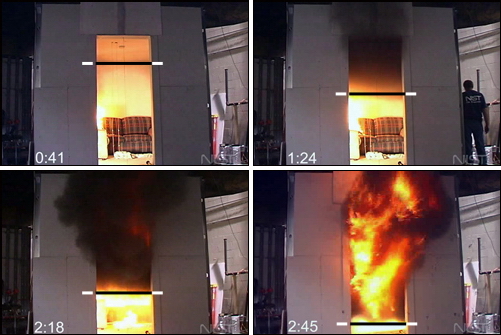
Note: Photos adapted from National Institute of Standards and Technology (NIST) ISO-Room/Living Room Flashover.
The distinction between fuel controlled and ventilation controlled is critical to understanding compartment fire behavior. Compartment fires are generally fuel controlled while in the incipient and early growth stage and again as the fire decays and the demand for oxygen is reduced (see Figure 2).
Figure 3. Fire Development with Limited Ventilation
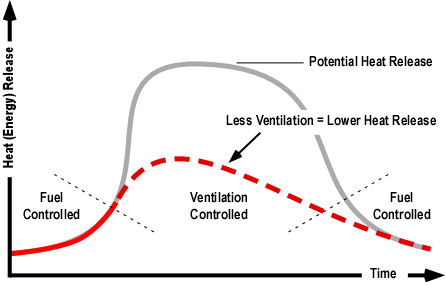
While a fire is fuel controlled, the rate of heat release and speed of development is limited by fuel characteristics as air within the compartment and the existing ventilation profile provide sufficient oxygen for fire development. However, as the fire grows the demand for oxygen increases, and at some point (based on the vent profile) will exceed what is available. At this point the fire transitions to ventilation control. As illustrated in Figure 1, a ventilation controlled fire may reach flashover, all that is necessary is that sufficient oxygen be available for the fire to achieve a sufficient heat release rate for flashover to occur.
Heat Release and Oxygen
Combustion, as an oxidation reaction requires sufficient oxygen to react with the available fuel. Heat of combustion (energy released) and oxygen required for complete combustion are directly related (Thornton, 1917).The energy released per gram of oxygen consumed during complete combustion of natural and synthetic organic fuels is fairly consistent, averaging 13.1 kJ/g (±0.5%) (Huggett, 1980).
Release of chemical potential energy from fuel is dependent on availability of adequate oxygen for the combustion reaction to occur. Interestingly, while the heat of combustion of various types of organic (carbon based) fuel varies widely, the amount of oxygen required for release of a given amount of energy remains remarkably consistent.
In the early 1900s, British scientist W.M. Thornton (1917) discovered that the amount of oxygen required per unit of energy released from many common hydrocarbons and hydrocarbon derivatives is fairly constant. In the 1970’s, researchers at the National Bureau of Standards independently discovered the same thing and extended this work to include many other types of organic materials and examined both complete and incomplete combustion (Huggett, 1980; Parker, 1977).
Each kilogram of oxygen used in the combustion of common organic materials results in release of 13.1 MJ of energy. This is referred to as Thornton’s Rule. See Fuel and Ventilation for a more detailed discussion of the application of Thornton’s Rule to compartment fires and ventilation.
Failure to Reach Flashover
Ventilation controlled compartment fires may reach flashover and fully developed compartment fires are generally ventilation controlled (IAAI, 2009). However, lack of ventilation may prevent a compartment fire from generating sufficient heat release rate to reach flashover. In some cases, ventilation controlled fires to not become fully developed, but decay and self-extinguish due to lack of oxygen.
In late 2007 an engine and truck company responded to a report of an odor of smoke in a three-story, wood-frame, apartment building. They discovered a ground floor apartment was smoke logged. They requested a first alarm assignment, forced entry, and initiated fire attack and primary search. Smoke was cool and to the floor, the fire was confined to an upholstered chair and miscellaneous items in the living room and at the time of entry was simply smoldering (see Figure 3). A rapid search discovered a deceased occupant in a bedroom remote from the fire.
Figure 3. Self-Extinguished Compartment Fire
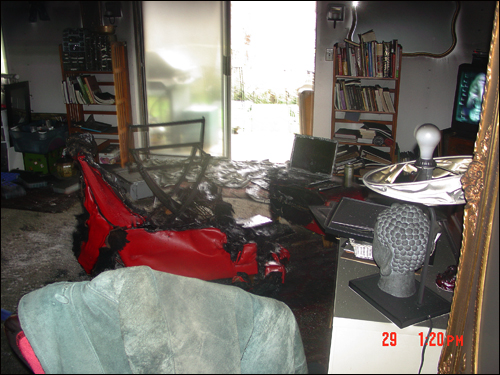
Note: Gresham Fire & Emergency Services Photo
While a fire involving an upholstered chair typically results in sufficient heat release rate for the fire to extend to other nearby fuel packages and ultimately reach flashover, this fire did not as evidenced by the condition of the Christmas tree on the opposite side of the living room from the point of origin (see Figure 4). The Christmas tree, like many other fuel packages in the apartment showed evidence of pyrolysis, but did not ignite.
Figure 4. Condition of Other Fuel Packages
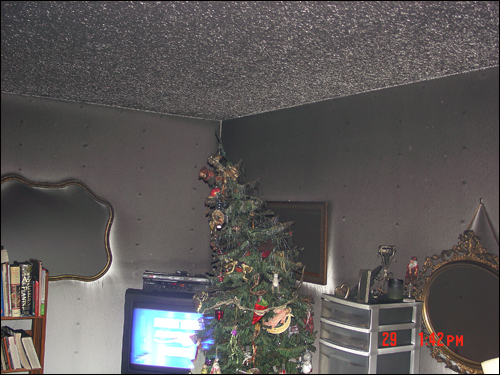
Note: Gresham Fire & Emergency Services Photo
Why didn’t this fire reach flashover? The fire occurred in early winter and the apartment’s energy efficient windows and doors were tightly closed. The developing fire consumed the oxygen available within the apartment and absent significant ventilation, decayed, and the temperature inside the apartment which had been increasing as the fire developed, dropped to a temperature slightly higher than would normally be expected inside an occupied apartment.
How might the development of this fire been different if it had been discovered earlier? What if a neighbor had opened a door or window in an effort to rescue the occupant? What if the fire department had opened the door without recognizing that the fire was significantly ventilation controlled?
When fire development is limited by the ventilation profile of the compartment, changes in ventilation will directly influence fire behavior. Reducing ventilation (i.e. by closing a door) will reduce the rate of heat release and slow fire development. Increasing ventilation (i.e. by opening a door or window) will increase the rate of heat release and speed fire development. Changes in ventilation profile may be fire caused (failure of glass in a window), occupants (leaving a door open), or tactical action by firefighters; but all will have an influence on fire behavior!
Figure 5. Ventilation Induced Flashover
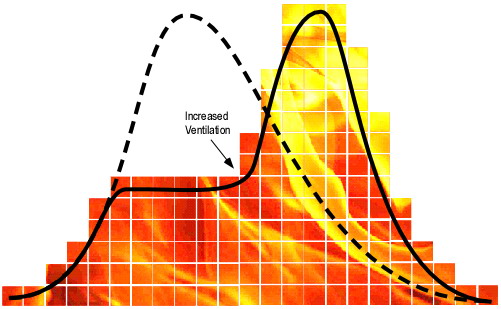
For many years firefighters have been taught that ventilation reduces the potential for flashover. While this is sometimes true, it is only part of the story. Increasing ventilation to a fuel controlled fire will allow hot gases to exit, transferring thermal energy out of the compartment and replacing the hot gases with cooler air (which increases heat release rate). The combined influence of these two factors slows progression towards flashover and increases the heat release rate required to reach flashover. The bathtub analogy presented in Understanding Flashover: Myths and Misconceptions [LINK], does not apply in this case, because when a fire is ventilation controlled, heat release rate is limited by the available oxygen. Under ventilation controlled conditions; increasing air supply by creating opening results in increased heat release rate. This increased heat release rate may result in flashover (see Figure 5). For more information see Hazards of Ventilation Controlled Fires.
Two Paths to Flashover
With adequate fuel and oxygen, a growth stage compartment fire may flashover and rapidly transition to the fully developed stage. Given adequate fuel, but lacking adequate oxygen (due to limited ventilation), a growth stage compartment fire may begin to decay before becoming fully developed. However, this can quickly change if ventilation is increased, potentially resulting in ventilation induced flashover.
Understanding these two paths to flashover is essential, but still does not provide a complete picture of the flashover phenomena. The next post in this series will will use several case studies to examine the influence of air track on flashover in multiple compartments the threat that rapid fire progression presents to firefighters.
Ed Hartin, MS, EFO, MIFIreE, CFO
References
Karlsson, B. & Quintiere, J. (2000). Enclosure fire dynamics. New York: CRC Press.
National Institute of Standards and Technology. (2005). ISO-room/living room flashover [digital video disk]. Gaithersburg, MD: Author.
Thornton, W. (1917). The relation of oxygen to the heat of combustion of organic compounds. The Philosophical Magazine,33(6), 196-203.
Parker, W. (1977). An investigation of the Fire Environment in the ASTM E 84 Tunnel Test, NBS Technical Note945. Gaithersburg, MD: U.S. Department of Commerce/National Bureau of Standards.
International Association of Arson Investigators (IAAI). (2009). Post flashover fires. On-Line Training Program, Downloaded August 6, 2009 from http://www.cfitrainer.net.